I bet the driver doesn’t think so.
Take a drive on dirt for the last 1/10th mile to my house.
As I’m typing this, I’m watching the town’s garbage collection truck rumble down the unreasonably steep and rugged road that leads to my home and my two neighbor’s homes. This is the third time the driver has come down the unmaintained road and he hasn’t quite gotten the hang of it yet. The loose rocks slip under his wheels on the way down and move aside to make deep ruts on the way up. His round trip from the last house on his route to our three garbage pails takes him about 15 minutes each day. He does this twice a week.
But that’s what the Town of Wickenburg wanted, I guess.
Four years ago, they annexed our three homes, against our will, into the Town. Apparently shopping and operating businesses in town wasn’t enough for our land-hungry mayor (who has since, thankfully, been defeated by someone who isn’t quite as obsessed with empire building). They wanted our property taxes, too. It didn’t matter that they weren’t interested in providing additional services for those tax dollars. The road to our homes remains unmaintained, there’s still no fire hydrant within at least a half-mile, we can’t get cable or DSL or town water or sewer services. They assure us that the town’s police and ambulance will come to our homes when called, but none of us have tried that yet. I don’t think they’ll find us. They gave us all new addresses, putting us on a street that apparently doesn’t exist — there’s no sign for it anywhere. My neighbors may have taken the hit of a “move” on their credit reports, but we didn’t — we changed our address right back to what it was.
But it’s worse for the rest of the folks annexed with us. They were promised that their road would be paved. That’s why they voted yes for the annexation, dragging us in with them. Their road remains unpaved to this day.
About two weeks ago, the Town added yet another insult. The town lawyer, who really ought to consider going into a different line of business, sent us a letter telling us that we were in violation of some town code because we didn’t have a contract with the Town for garbage pickup. The letter threatened legal action, with a daily fine of $300 or so dollars a day. The letter was nasty and accusing — as if we were purposely denying the town $19.60 per month of revenue.
I don’t take kindly to threatening letters. I got seriously pissed off and started making some angry phone calls.
Turns out that when the Town annexed us, the letter they sent to inform us of all the changes we could expect — like our new address — also told us that garbage service was available from the town. I don’t have the letter anymore — I tossed it long ago — but I don’t recall the letter saying garbage pickup was required. There’s a big difference, especially to a writer, between available and required. We already had garbage pickup from the local sanitation company and it was cheaper, so I didn’t see any reason to make the change.
My call to Town Hall got me many apologies from the person I spoke to. She told me they’d gotten a lot of complaints about the lawyer’s letter. I’m glad. It means that I’m not the only person who gets angry when some idiot backwoods (or back desert, in our case) lawyer flexes her fingers without thinking on a word processor’s keyboard. Apparently, the townspeople aren’t quite as lifeless as I thought they might be.
Since garbage pickup with the town was now roughly the same cost as with the private company and they’d come pick up twice a week rather than just once, we signed up with the town. It’s unfortunate for the other company. If they keep losing business to the town, they’ll soon go out of business. But heck, what does the Town of Wickenburg care about the viability of local businesses?
So now the garbage truck lumbers down our steep, rutty, loose gravel road twice a week to collect garbage from three pails. We make very little garbage because we recycle so much — and no, they won’t pick that up — so they’re not collecting much from us on every visit. The truck crawls back up at 5 to 10 miles per hour, spinning its tires once in a while to dig one or two new ruts that it’ll have to drive back over a few days later.
After the next rain, my neighbor will pull out his Bobcat and scrape down the road surface. My other neighbor will drive up and down with a home-made smoothing bar — think railroad steel and chain link fence dragged behind a pickup truck. We’ll do our part by driving up and down the hill at 15 miles per hour without stopping or with 4WD turned on in our pickup — the only way to avoid making ruts.
And the town will collect an extra $58.80 per month in revenue for the 2 extra hours it takes its truck and driver to include us on the route.





 Parked in the desert north of Phoenix. Photo by Jon Davison.
Parked in the desert north of Phoenix. Photo by Jon Davison.

 For a moment, I considered panicking. Then I realized how dumb that was and inched backwards on my butt, pulling my feet and walking stick with me. After a few moves, I was on firm enough sand to get back on my feet.
For a moment, I considered panicking. Then I realized how dumb that was and inched backwards on my butt, pulling my feet and walking stick with me. After a few moves, I was on firm enough sand to get back on my feet.

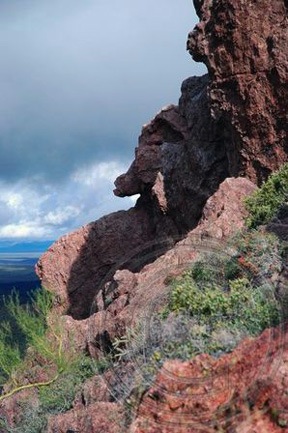

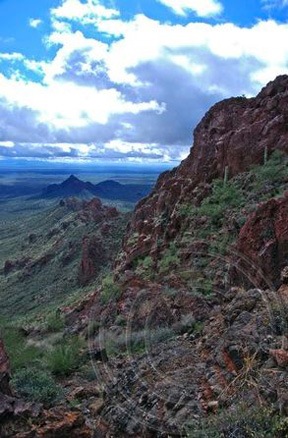
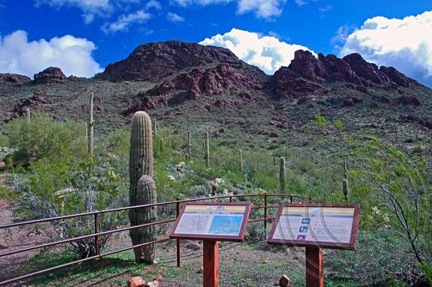
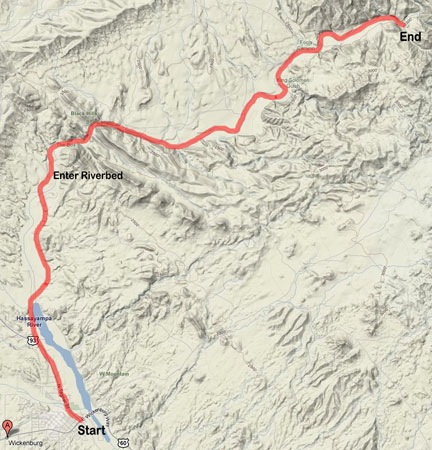
 We made a few brief stops. Box Canyon was one of them. But there were motorcycles there with loud engines and we didn’t stay long. Instead, we continued upstream, into the narrow slot canyon. The water flowed from wall to wall within the canyon and I had the windshield wipers going as I slipped around in the soft sand. We stopped for a moment to take a photo of the way we’d come.
We made a few brief stops. Box Canyon was one of them. But there were motorcycles there with loud engines and we didn’t stay long. Instead, we continued upstream, into the narrow slot canyon. The water flowed from wall to wall within the canyon and I had the windshield wipers going as I slipped around in the soft sand. We stopped for a moment to take a photo of the way we’d come.
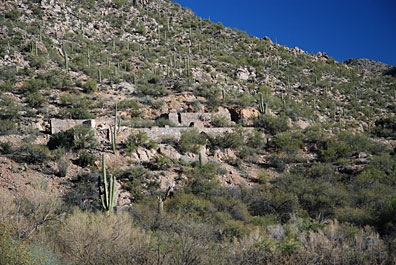 We continued on. The river was flowing through a canyon, but the way was still passable. We soon saw the remains of a mine site on the right side of the hill. We turned the Jeep into a promising canyon where other vehicles had driven but soon reached a dead end where rocks blocked our way. We parked, got out, and hiked up the hill.
We continued on. The river was flowing through a canyon, but the way was still passable. We soon saw the remains of a mine site on the right side of the hill. We turned the Jeep into a promising canyon where other vehicles had driven but soon reached a dead end where rocks blocked our way. We parked, got out, and hiked up the hill. Following a narrow path for a better view down into the river, I came across a tunnel carved into the solid granite at the side of the hill. We passed through and continued onto the other side.
Following a narrow path for a better view down into the river, I came across a tunnel carved into the solid granite at the side of the hill. We passed through and continued onto the other side.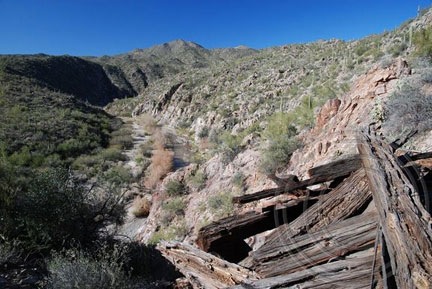
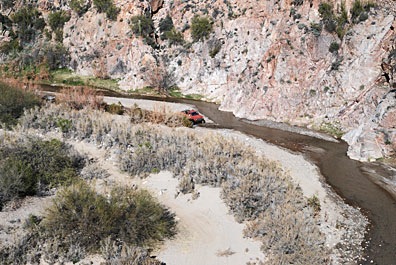 As we admired the view, we heard the sound of a vehicle. Down in the riverbed, a truck was driving downstream. It stopped only long enough for the driver to point out a mine shaft to his passenger, then continued on down the river. I don’t think they saw us or our Jeep.
As we admired the view, we heard the sound of a vehicle. Down in the riverbed, a truck was driving downstream. It stopped only long enough for the driver to point out a mine shaft to his passenger, then continued on down the river. I don’t think they saw us or our Jeep.